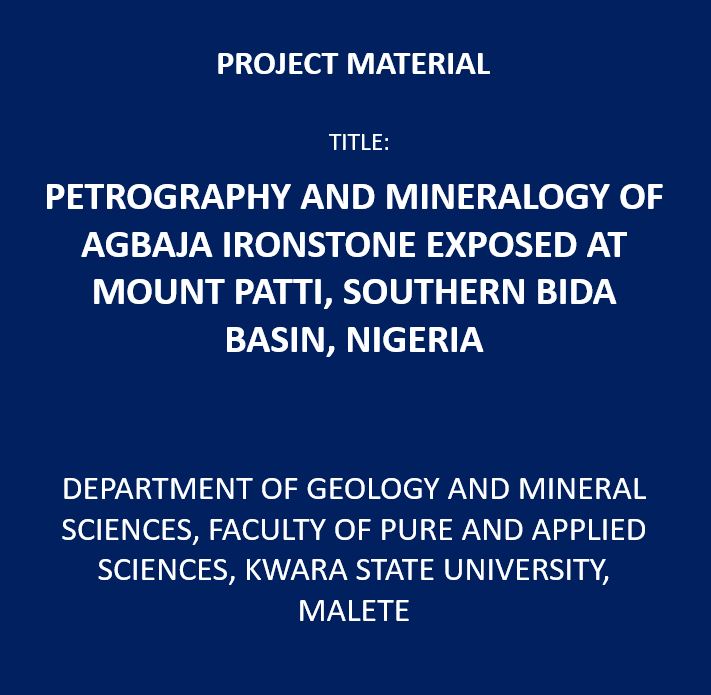No products in the cart.
Petrography and Mineralogy of Agbaja Ironstone Exposed at Mount Patti, Southern Bida Basin, Nigeria
₦10,150.00
PETROGRAPHY AND MINERALOGY OF AGBAJA IRONSTONE EXPOSED AT MOUNT PATTI, SOUTHERN BIDA BASIN, NIGERIA
- PROJECT YEAR: 2021
- NUMBER OF PAGES: 86
- FILE TYPE: PDF
- DEGREE: BACHELOR
- INSTITUTE: DEPARTMENT OF GEOLOGY AND MINERAL SCIENCES, FACULTY OF PURE AND APPLIED SCIENCES, KWARA STATE UNIVERSITY, MALETE
ABSTRACT
Agbaja Ironstone formation at Mount Patti was investigated and sampled for petrography and mineralogy studies with a view to achieve detail characterization of the ironstones. The field investigation reveals the relationship of the ironstone with other lithologies
such as sanstone, Siltstone and claystone. Textural characteristics reveal that the ironstone are mainly oolitic and pisolitic coated graines cemented by kaolinitic clay. Detailed textural characteristics which include shapes (level of roundness of a coated grain due to transport and burial depth/history) and sizes (ooids and pisoids from 1-2mm and <2mm respectively) of coated and uncoated grains and levels of iron replacement of the precursor material were deduced from microscopic analysis through thin section petrography. Goethite (50%), Hematite (13.5%), magnetite (13.5%) Quartz (15%) were identified through XRD as the main mineral phases in the ironstone. The ironstone of Mount Patti is said to have been formed by the deposition of water laid detrital quartz grains and iron bearing clays under shallow, quite water depth and current which consists of small scale shallowing upward cycles of parallel laminated hematitic Sandstone and laminated silty ferruginous Siltstone. The ironstone of Mount Patti ridge is said to have been formed by the deposition of water laid detrital quartz grains and iron bearing clays under shallow, quite water depth and current which consists of small scale shallowing upward cycles of parallel laminated hematitic sandstone and laminated silty ferruginous siltstone. The ironstone may be said to be a type of ironstone inputted depositional components which composed mainly from silt-sized detrital quartz grains embedded
within iron bearing clays. These components are vertically and laterally distributed within the depositional environments by the impact of the current and the action of wave. Diagenetic processes play important roles in petrographic and mineralogic evolution.
These diagenetic processes include; (a) Diagenetic recrystalization and dehydration of precursor amorphous iron bearing clays and the intimately associated iron oxyhydroxides and formation of goethite and hematite (b) corrosion and embayment of the quartz grains
by enclosing different iron minerals (c) oolitization throughout the tangential growth of the iron oxyhydrides during their dehydration and recrystalization and formation of ooids.
No product has been found!
